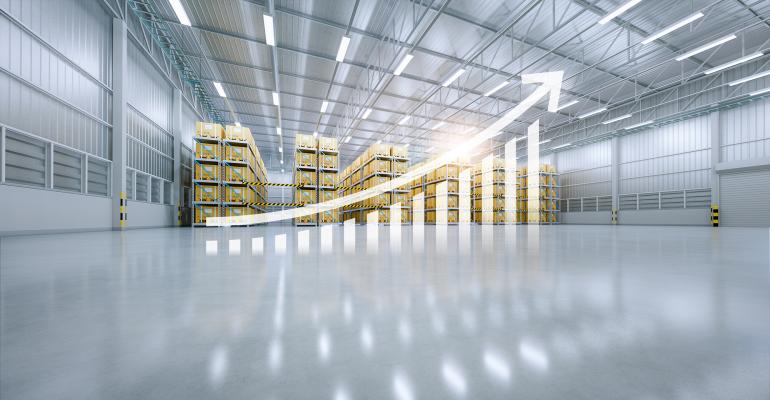Despite strong fundamentals that are continuing to position industrial as one of the most favored property sectors, rising capital costs and slowing economic growth are creating a cooling effect on what has been a white-hot industrial investment market.
Exclusive survey results from the ninth annual WMRE industrial market survey show that the sector remains firmly entrenched as one of the most attractive property sectors. On a scale of 1 to 10, industrial led all sectors with a mean score of 7.5 followed by multifamily at 7.4 and seniors housing at 7.0. Past WMRE surveys have consistently ranked industrial and multifamily as top sectors for investors. However, it also is notable that both industrial and multifamily took a step back compared to the 2022 survey, from 8.0 and 7.8 respectively. The downshift from “great” to “pretty good” is likely a sign of the economic challenges ahead.
“I characterize the market as we just took a pie out of a 1,000-degree oven. It’s still hot and difficult to transact in from an occupier standpoint, but it is starting to cool from that very high level,” says Mark Russo, Savills senior director and head of industrial research. Slowing demand is evident in leading indicators such as rising sublease space and a decline in leasing velocity. According to Savills, more than 80.3 million square feet of sublease space was on the market at the end of fourth quarter. And after hitting a record low of 3.9 percent in mid-2022, vacancy ticked slightly higher to 4.0 percent at year-end, according to Savills. However, vacancy levels remain well below the 8 percent that existed prior to the GFC, suggesting that the industrial market is still in a strong position heading into a slower economy. “I would say that we’re coming down from a frenzied to a more balanced market for the foreseeable future,” says Russo.
Investors are holding onto assets
Investors continue to have a huge appetite for industrial assets, but property sales have been stymied by a persistent bid-ask gap. “We still have a gigantic number of investors who are interested and have capital allocated towards industrial, but it is almost irresponsible to pay yesterday’s numbers because you can’t justify it,” says Justin Smith, a senior vice president and principal at Lee & Associates | Irvine. And it has been difficult for owners to contemplate a price reduction when they have increasing NOI due to strong property fundamentals. So, in many cases, owners are opting to hold cash-flowing assets and are not selling unless they have to for some reason, he adds.
Consistent with survey results over the past few years, most respondents (56 percent) prefer to hold onto assets or buy more (37 percent) over the next 12 months with few sellers (7 percent). Despite the boom in industrial investment sales in recent years, those who reportedly want to buy more industrial has maintained a relatively steady level between 33-38 percent over the past five years. The property types most in demand continue to be warehouse/distribution facilities at 55 percent, followed by last mile facilities (45 percent) and flex industrial (37 percent).
Like many investors, BKM Capital Partners was proceeding cautiously in the second half of 2022 due to the higher rate environment. “We are risk on for 2023, because of the stellar fundamentals,” says Turner. Currently, the firm has 11 industrial business parks under contract that will close in the first quarter of 2023 with a total combined value of about $350 million. According to Turner, the firm’s occupancy levels and leasing spreads – the difference between the existing and a new rate—have never been higher; credit loss is at an all-time low; and tour activity for prospective tenants also remains very high. BKM Capital also is starting to see some adjustment in seller expectations with cap rates that have moved 50 to 75 basis points higher since mid-2022. “We feel like we can get some good risk-adjusted returns by taking positions at this point in the market,” says Turner.
Industrial sale-leasebacks have been less affected by rising interest rates as the financing mechanism stacks up favorably compared to other corporate financing alternatives, such as commercial loans or corporate bonds. and remains a fairly active market. However, investors are scrutinizing tenant credit more carefully to make sure there is confidence in the underlying business. Views also have shifted more in favor of shorter-term leases. According to Smith, investors are now paying a higher cap rate for a longer term lease, because they believe longer term leases limits the ability to raise rents in the future. “That is telling you that landlords are still expecting rents to go up,” he notes.
More than one-third of respondents (38 percent) report seeing new competition pursuing net lease industrial assets. However, views on new entrants has declined significantly compared to last year when two-thirds of respondents reported new entrants. Respondents see the newest competition coming from large PE funds (51 percent), smaller private investors (51 percent) and 1031 investors and HNWIs and family offices (48 percent).
The full results of the survey will be published in a longer report and highlighted in an upcoming WMRE Industrial/Logistics Real Estate Trends Virtual Forum, taking place in April. (For more information about the upcoming forum, click here.)
Survey methodology: The WMRE research report on the industrial real estate sector was completed via online surveys distributed to readers of WMRE and Wealthmanagement.com in February 2023. The survey yielded 220 responses from a diverse group that includes both private and institutional investors, developers, brokers and lenders among other industry participants. Overall, 44 percent said they operated in the East, followed by the West (39 percent), South (39 percent) and Midwest (32 percent). Nearly half of respondents (45 percent) hold the titles of owner, partner, president, chairman, CEO or CFO.





